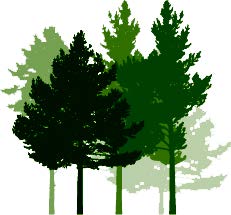Search technical reports
A Heartwood Durability Study on Leyland Cypresses
By C Low, T Jones, D O Callahan, P Milne, C Chittenden, June 2009.
Download FFR-_DS012 (pdf)
Executive summary
Leyland cypresses are hybrids between Cupressus macrocarpa and Chamaecyparis nootkatensis. They have been propagated vegetatively for at least 100 years and offer the opportunity to look at heartwood durability on ramets of the same clones across several sites.
This study was based on 10 ramets of three Leyland clones (Leighton Green, Green Spire and Naylors Blue) at Strathallan forest, and 10 ramets of the same three Leyland clones and the Ovensii clone (C. lusitanica x Ch. nootkatensis) at Gwavas forest. Three bark to bark cores of 12 millimetre diameter were taken from each ramet using a motorised corer. 60-millimetre sections of heartwood were cut from each core from close to the pith and also just inside the heartwood / sapwood boundary. The distance from the pith to the heartwood / sapwood boundary was measured along with the distance from pith to bark. The rings of sapwood were counted. The percentage of heartwood, percentage of sapwood, number of sapwood rings and sapwood length were considered to be significantly different between clones, but no site differences were seen except for length of sapwood. There were no interactions between site and clone.
Heartwood colour differed by clone, with Green Spire having the brightest colour and highest percentage of heartwood, closely followed by Leighton Green and Ovensii. Naylors Blue had the least amount of heartwood and less distinctive heartwood boundaries, with some trees having a patch of heartwood with sapwood on both sides. Photographs were taken of all cores before sections were cut.
Of the three fungi used in the Sutter trial, the white rot fungus (Trametes versicolor) caused the greatest weight loss. Weight loss for the two brown rot fungi (Oligoporus placenta and Gloephyllum trabeum) was negative, probably because some fungal mycelia had added to the original weight. The control blocks and cores of P. radiata confirmed that the fungi were alive and operating at normal efficiency.
Site had the greatest effect, with wood from Strathallan suffering significantly greater weight loss than wood of the same clones from Gwavas. Clones varied in weight loss, but not significantly, and position within the tree was also not considered significant. The effect of site could elevate durability from class 3 (moderately durable) at Strathallan to class 2 (durable) at Gwavas if the test had been conducted for a longer timeframe.
There was some interaction between fungus and site explained by a (non-significant) greater weight gain of the brown rot with least effect (Oligoporus placenta) at Strathallan, which went against the trend shown by the other two fungi.

 Specialty Timbers New Zealand
Specialty Timbers New Zealand
No posts yet
Add a post